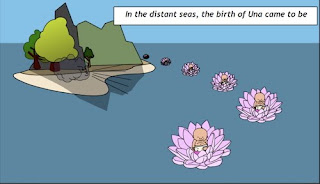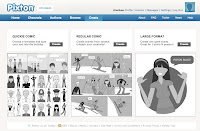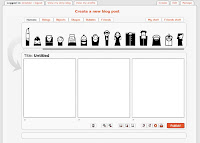With comics gaining popularity, library and education professionals are aiming to provide comics and graphic novels to their users and students. In the wake of this popularity, books about comics/graphic novels are starting to become commonplace on the shelves of these institutions. Books analyzing comic artists, books analyzing comics and books of how to draw comics are just a few examples showing the influence of comics. It is not only a matter of providing books to users and students but it is also becoming a trend to assemble these resources to use in classroom and library activities.
Comics in the Classroom
Online, there is a plethora of material for using comics and creating comics in the classroom. Comics in the Classroom is one site that provides lesson plans, news/reviews on comics, and webcomic links. Teaching Comics, the online presence of the National Association of Comics Art Educator, provides study guides, handouts of how to draw different styles of comics, and articles about comics in the classroom. Lastly, Comics in the Classroom: 100 Tips, Tools, and Resources for Teachers, provides links to articles, listing of resources, suggested comics and comic creators to name a few. Teachers, in schools and online, are coming together to share classroom learning experiences. For additional information, look to Comics in the Classroom on the side menu.
Comics in the Library
Compared to classrooms, libraries just becoming a part of the comic activity scene. The focus of creating comics organically (paper and pen/pencil) is the norm. One such example is the Cape May County Library in New Jersey. Two accomplished comic artists, Raina Telgemeier, illustrator of ‘The Babysitters Club” graphic novels, and David Roman illustrator of “Jax Epoch” and writer of “Agnes Quill," put on a comic creating workshop for the teens. While comic workshops are starting to become a part of library activities, librarians are not taking advantage of reviewing and/or creating online comics and there is little academic or online evidence to suggest otherwise.
Purpose of this Blog
The purpose of this blog will be to present and review 8 online comic creators. This review will analyze the flexibility, creativity, and degree of access each comic creator provides. Most of the criteria will be taken from the "Reading the Pictures" section of LIS 404/518 Lecture notes. Based on these notes, the criteria will serve to establish whether a comic creator provides all the necessary elements of a comic. There are aspects of webcomics that do not relate to organic comic creation thus additional criteria will be presented to cover these areas. The criteria:
- Background: This is to show the reader when and where characters are. Backgrounds set the moods, can be stereotypical in order to convey atmosphere and sets the stage for characters or is a stage in its own right. In context to comic creators, is there variety in their selection, are there stereotypes, do they set a mood?
- Body Language: Posture, gestures with face, hands and arms illustrate personality, convey inner thoughts, or potential action. With comic creators, is there variety in the selection of arm gestures, facial expressions (found in mouth, lips, eyes, eyebrows), available postures (slumping, rigid, sitting, standing, poising, etc)?
- Clothing: The shape of the clothing suggests implied movement. The continual use of one clothing style shortens time to draw and focuses on message rather than appearance. Comic creators must be gaged for diversity or simplicity of clothing (tops and bottoms, shoes, masks, hats, accessories, etc, props) in representing the personality of their character.
- Devices: Speed lines, the visual equivalent of sounds and any other devices are to be immediately recognizable and add to the mood or message of the comic. With comic creators, are there devices, and if so, are there a variety to choose from?
- Focus: Depth of picture created by an object or character sets a tone and shows relevance of object/character to the story. It must be considered whether comic creators offer this feature or not.
- Gutters: "The primary aim of the sequential artist is to get the reader so involved in the following action that they "fill in" the gaps between the panels and move at the author's intended pace."Do comic creators provide a variety in gap styles or are there even any gaps?
- Lettering: Variations in size and proportion sets to display or emphasize; captions that are not in speech bubbles but found in boxes at the top or bottom of the frame; sound effect lettering can be found inside and outside of captions. What do comic creators provide in context to lettering?
- Panels: Panels define the parameters; set the rhythm of the story; is a link between the reader and the story; comes in different shapes and sizes. Do comic creators use one standard of panneling or is there variety?
- Speech Balloons: Speech balloons are usually ovals, rectangles with rounded corners, or irregular shapes billowing horizontally around the words. Direct speech gives more control to the characters. With comic creators is there only one style of speech balloons or a variety? Can the speech balloons reverse, be made larger or smaller?
- Stereotypes: Stereotypical backgrounds, characters and objects help the reader to easily identify the message or situation whether there is a connection to reality or not. Comic creators have stereotypes, but to what extent and is their selection entirely stereotypes?
- Registration: With comic creators, can a user immediately create a comic before registering? What is the process?
- Accessibility: Once the comic is created how accessible is it? How is the creator able to make it accessible or allow accessibility of the comic to others?
- Intended users: Who is the comic creator presenting their style of comics to?
Defining Online Comic Creators
Creating webcomics falls under two categories: creating original work through drawings or photographs or creating original work through the provision of templates. Online comic creators provide templates of bodies and backgrounds. Several comic creators also allow the ability to upload photographs and to add or change the structure of the content. Some common features of function for comic creators is creating a user account, emailing webcomics to friends, posting finished comics to the comic creator website to be viewed by other members, and rating or leaving comments on other user's webcomics. This blog will only review comic creators that provide templates, the ability to use photographs to make webcomics and require no fee to register.






























